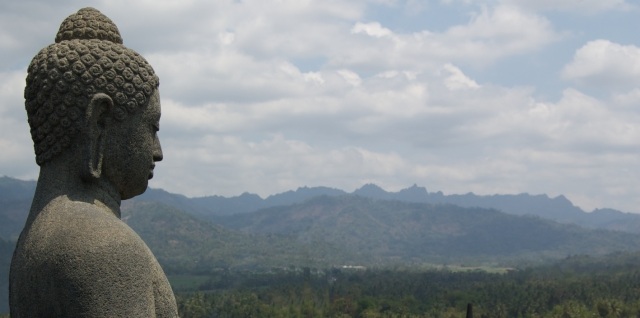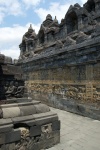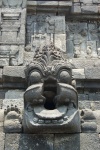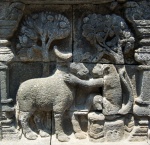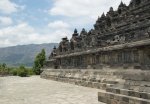 नमस्ते We’re on a trip to Indonesia at the moment, to Yogyakarta – and as any good tourist knows, time spent there should mean a trip to the nearby Buddhist temple, Borobudur. It’s the world’s largest Buddhist temple, built in the 9th century and contains 2672 relief panels (sadly, many of which are corroded by rains and time).
नमस्ते We’re on a trip to Indonesia at the moment, to Yogyakarta – and as any good tourist knows, time spent there should mean a trip to the nearby Buddhist temple, Borobudur. It’s the world’s largest Buddhist temple, built in the 9th century and contains 2672 relief panels (sadly, many of which are corroded by rains and time).
Borobudur is a spectacular sight, even when glimpsed from afar, when the many people who visit each day appears as ants, crawling up its hillside. It’s history is fascinating too: after its initial design and building, it was abandoned for centuries, until eventually uncovered by the British and later restored by UNESCO. It has survived earthquakes and bombings.
What I especially enjoyed about Borobudur was its sense of narrative, in the smaller and grander sense. In the smaller sense, one is surrounded by friezes cast in stone that occupy most walls of the temple. Each tells a part of the story of the Buddha and Buddhism, although ‘reading’ them for the uninitiated (like me) is difficult, given their highly symbolic quality.
The grander narrative appeals equally. Entering from the Eastern gate (it’s the main gate, where everyone enters: we couldn’t find a signpost for it until later), the traveller begins a path that takes him counter-clockwise from bottom to top. This reflects the path of life, where on the lower level the friezes tell stories of earthly desire, until one passes through the gate of formlessness and into nirvana – where the Buddha can be found in all the 72 stupas there (theoretically, he’s actually only in a few here), including the main one that stands above them all. The photos below give some idea of what there is to see there.
- Contemplation
Thus to enter Borobudur is to become, at least for the time you are there, a pilgrim, on the path of a Buddhist life, to pass from a life of earthly desire to formlessness and eventually enlightenment. I am not a Buddhist and nor am I converted by my visit – but this immersion into an already hugely impressive monument, with its rich detail and beautiful natural environment, has left an indelible mark on me and for, I’m sure, many of those who visit. नमस्ते
